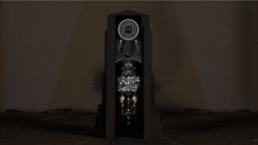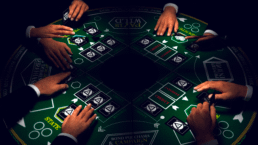Secret Thresholds, Digital Poetics: "Soft Crash" by Alan Warburton and "Glyph" by Depart
Julia Madsen
The online digital artworks “Soft Crash” by Alan Warburton and “Glyph” by Depart put forth an encrypted and arcane digital poetics. These videos are like screens between the known and unknown, equally composed of a kind of surreptitious logic. “Soft Crash” leads the viewer through an otherworldly experience centered on spectacle and speculation, or what Warburton describes as the relationship between image and theory in a presentation on the making of the video, where he uncovers the impulses behind his experimental digital animation practice. Additionally, in his notes accompanying “Soft Crash” published on his website,1 Warburton states that “[o]ne of the side effects of creating something so dense is that a lot of people might watch and simply feel mystified by what’s going on,” and the viewer indeed moves scene-by-scene through this digital realm, searching for meaning within magic. Similarly, in Depart’s “Glyph” the viewer feels as though they have slipped into another world, one which seems to be located in both ancient and futuristic temporalities.

Warburton writes that “Soft Crash” is “a meditation on the financial collapse of 2008 and the subsequent public bank bailouts, austerity economics and recent trend towards nationalist isolationism,”1 and is inspired by a card game he once played where “[n]o player could win, yet no player could lose so long as they continued circulating the cards.”1 The work opens with a kind of “test card” suggesting “an idea of calibration,” locating the video “in a space of reflexivity” while implying a well-wrought, experimental engagement. The next scene presents the representation of a card game, where sets of floating hands pass around playing cards in a seemingly unending loop. I seem to have failed to notice, until ten or so viewings, that on the green felt table next to the four sets of hands are the words “Industry,” “State,” “Finance,” “Property.” There are mirrors partitioning each set of hands, and an LED display showing stock market data, all of which coalesce into a singularly spectacular event.
My favorite scene occurs at the end when we enter a factory room/chamber within a mansion. We see disembodied torsos near a conveyor belt undergoing repeated, mechanical motions. The camera moves to a shot of two torsos reaching out as if to shake hands, and in the middle of them is a blue screen on which the words appear: “Dynamic,” “Standard,” “Fresh,” “Personal,” “Natural,” “Dynamic,” and finally, “Soft Crash.” I imagine this as some kind of factory-turned-underworld nestled within the basement of late capitalism, a place where mechanical-human-bodies perform tasks absent of real human interaction. As Marx and Engel state, “all that is solid melts into air.”

On their website, Depart describes “Glyph” as a projection sculpture “with references to ritual monuments such as obelisks or stelas,” which “deals with cyclic chance and constantly regenerates itself.” As such, the video points toward a kind of techgnosis – a term coined by Erik Davis in his eponymous book which uncovers “a secret history of the mystical impulses that continue to spark and sustain the Western world’s obsession with technology.” “Glyph” invokes a mystical, ritualistic experience through which glyphs are projected onto the obelisk. We see illuminated symbols which serve as a kind of secret text based on geometric shapes — as Depart notes, these shapes “are permanently evolving and restructured based on linguistic rules.” While this sculpture is undoubtedly reminiscent of an ancient realm, it provides a kind of prescient insight into contemporary communication technology and the use, for instance, of emojis as a nascent albeit strikingly primeval visual language.2
“Glyph” and “Soft Crash” compel us to re-watch, examine, and unpack their images with the understanding that at least part of their beauty and ephemerality resides within unknowability. These works create an experience which generates new ways of understanding emergent art practices with respect to technology/techgnosis, image, and theory. Ultimately, they show the type of work that is possible when bridging creative and theoretical digital practices, creating pathways toward better understanding our own technological moment under late capitalism.
1. https://alanwarburton.co.uk/soft-crash/
2. http://www.bbc.co.uk/newsbeat/article/32793732/uks-fastest-growing-language-is-emoji
*
Julia Madsen is a multimedia poet and educator. She received an MFA in Literary Arts from Brown University and is a PhD candidate in English/Creative Writing at the University of Denver. Her first book, The Boneyard, The Birth Manual, A Burial: Investigations into the Heartland (Trembling Pillow Press) was listed on Entropy’s Best Poetry Books of 2018.